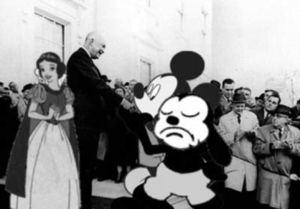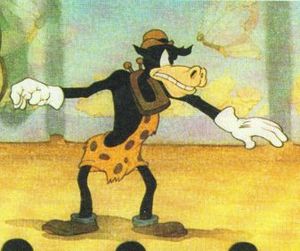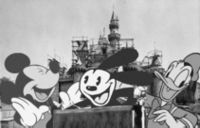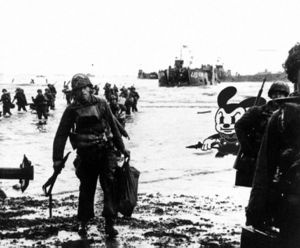User:KP/Oswald the Lucky Rabbit
Oswald “Lucky” Rabbit (September 5, 1917–January 22, 1956) was the first modern-day president of the Disneyland Confederation. He was instrumental in in the Disneyist movement and was a founding member of the American Disneyist Organization. Rabbit was killed by gunfire during a 1956 coup led by Mickey Mouse the Great.
The Early Years[edit | edit source]
Oswald Rabbit was born in Los Angeles, California. He was a full-blooded member of the Faneída tribe. Oswald’s father, Robert T. Rabbit, was a practicing attorney while Oswald’s mother, Rosalie Rabbit, stayed at home. He had an older brother named Harvey who died before Oswald was born. Harvey was killed by a Mr. Elwood Dowd in a drunk driving accident; Dowd would figure prominently in Oswald's life later. For the most part, Oswald’s childhood was idyllic. He was an honor student in high school and excelled at track.
One of the more influential persons in Oswald’s early years was Jane Hare, Oswald’s grandmother. Every summer, Oswald would spend his time at his grandmother’s farmhouse. There, his Grandmother Jane would tell him of the old Disney ways and traditions. One summer when Oswald was 8, a hunter’s stray bullet strafed his ear. Oswald emerged uninjured. After that day, Oswald’s grandmother gave him the moniker “Lucky.” Oswald Rabbit went by that nickname for the rest of his life.
Rabbit and Early Disneyism[edit | edit source]
Formation of the American Disneyist Organization[edit | edit source]
In 1935, Oswald Rabbit left home to attend USC to study law. There, he met other descendants of Disneyland’s exiled tribes. It was during the college years that Rabbit formulated and articulated political Disneyism—the idea that Disneyland’s tribes, displaced since the end of the Mexican-American War in 1848, should return to their former lands and create an independent state. In 1937, Rabbit, along with Doc Dwarf and Jiminy Cricket, signed a political manifesto calling for an end to American occupation of former Disneyland territories. Thus formed the American Disneyist Organization (abbr: ADO), the foremost Disneyist group of the time. Many future leading lights of Disneyland would rise to power through membership in the ADO: Mickey Mouse the Great, Admiral Donald Duck, Agriculture Minister Snow White, Cultural Affairs Minister Tinkerbell, General Dumbo Elephant, and Education Minister Peter Pan.
During World War II, Rabbit served as a Ranger captain. He participated in the D-Day invasion on June 6, 1944. During his military service, Rabbit was known for his selflessness and bravery. He earned several awards and medals for his valor.
Rejection of Violent Methods[edit | edit source]
Oswald Rabbit became embittered after his return to civillian life; he had risked much for his country, yet his country continued to treat him and other Faneídans as second class citizens. He resumed work for the ADO and was part of its more militant fork. However, this changed entirely after Rabbit met and confronted a ghost from the past: Elwood P. Dowd, the killer of his brother.
Elwood Dowd had been haunted by the tragic accident in which he took the life of Harvey Rabbit, Oswald Rabbit’s older brother. Suffering from advanced stages of alcoholism, he often hallucinated that he was being chased by a giant rabbit. In 1950, he was involved in another drunk driving accident, this time, in a “stranger than fiction” coincidence, with Oswald.
The accident was minor, but led to a major revelation for Rabbit. In his pamphlet, Non-Violent Civil Disobedience, Rabbit described this change of heart:
My first reaction, upon seeing that the other driver was Dowd, was anger and hate. Here was the man who drunkenly killed my brother, again drunk and behind the wheel. I didn’t know what I wanted to do. I wanted to pull my teeth out. I wanted to destroy this man. Then I saw him shaking in fear at the sight of me. He kept saying, over and over, “Harvey? Is that you? I'm so sorry! I’m so sorry, Harvey. I’ll never drink again. Yes, I know I’ve made that promise before." He kept speaking to an empty space over his right shoulder, a space occupied by the “ghost” of my brother, I was later to learn.
It was at this moment that I realized that all the resistance to our cause was due to human fear. They hated us, persecuted us, discriminated against us, because they feared us. And we couldn’t overcome that fear with anger or hate. That would only serve to further increase their fear, and thus they would resist the changes that were imperative. No, we could overcome their fear with love and with education. We could educate them through non-violent civil disobedience, making them look at the terrible system they had instituted through their fear and hate.
Rabbit represented Dowd in court on the drunk driving charge. He obtained, in lieu of jail time, rehabilitation for Dowd at the Betty Ford Clinic, which was a great precedent at the time. He then continued his work for the ADO with new fervor, convinced that he could bring about change in a peaceful manner, although his ideas were met with some resistance from his more militant compatriots. He organized a series of civil disobedience actions, the most famed of which were the Orange County movie theater sit-ins and the Gracey Estate takeover. The Gracey Estate protest in 1954 brought Mickey Mouse the Great into international renown, with his famous “I Dream of Having” speech.

By early 1955, the momentum for redressing the grievances of Disneyland had become nearly unstoppable. On July 17, 1955, President Eisenhower, at the behest of Secretary of State John Foster Dulles, signed the Treaty of Corporation. The treaty gave immediate recognition of Disneyland’s independence. It also formalized the territorial boundaries of the new nation and established trade and economic relations. Oswald Rabbit was made Disneyland’s interim president. It was intended that he was to remain president only temporarily until the time that a new constitution could be written.
Policy During the Rabbit Administration[edit | edit source]
The first few months of the Rabbit administration were chaotic and unruly. The economic and physical infrastructure of the new nation was practically non-existent. Food riots broke out with alarming frequency. In addition, numerous property disputes caused by returning Disneyland tribes created an environment of endemic violence. Compounding the domestic challenges, pirates were raiding Disneyland’s trade and most nations were unwilling to welcome Disneyland into the family of nations—believing that Disneyland was a land run by the mentally insane (this impression was perhaps first propagated by Mickey Mouse’s “I Dream of Having” speech). In the meantime, work on the new constitution was continually delayed and sidetracked by factional infighting.

Rabbit’s main cabinet advisors were Minister of Foreign Affairs Patricia Pig, Minister of Interior Horace Horsecollar, and Disneyland Defense Forces director Captain Pete. Most historians regarded Rabbit’s domestic and foreign policies as ineffectual and ill thought out. Squabbling among the ministers led to incoherent decisions. In addition, most of the leading ministers were simply incompetent. Horsecollar’s “Let’s Eliminate Violence by Politely Getting Tough!” campaign was considered most laughable, even in its own time.
By late 1955, just months after independence, the economic and security situation had spiraled out of control. Economic output was close to 0 and pirate attacks led to losses of almost 97% of trade. A group of disgruntled military officers, led by Mickey Mouse, decided that drastic change was required and met in that winter in a fateful meeting that would forever change Disneyland’s history.
The Coup de Rat[edit | edit source]
Summary of Events[edit | edit source]
Early the Sunday morning of January 22, 1956, military officers, led by Mickey Mouse, took over ministry buildings and media outlets throughout Disneyland in a Coup de Rat. At approximately 8:45 am, Oswald Rabbit was alerted by advisors of the situation. Rabbit was advised to leave Disneyland in order to gain foreign support for returning the nation to civilian rule. Shortly past 1:00 pm, Rabbit arrived at Disneyland’s only airport. Troops supporting the coup had blockaded the road to the airport. As Rabbit’s entourage approached the airport, a gunfight broke out. A bullet pierced Rabbit’s skull in the ensuing battle. Rabbit was immediately killed. Thus, at the young age of 38, the luck of Oswald the Lucky Rabbit finally ran out.
Oswald Rabbit’s wife and 28 children meanwhile fled across the northern border to exile. They later became international voices of opposition to the dictatorial regime of Mickey Mouse the Great. When military rule was lifted in 1970, many of them returned to their native land. Some rose to power in the civilian government of the post-Mouse years.
Was the CIA Complicit in the Assassination of Oswald Rabbit?[edit | edit source]
Many of the precise details surrounding Oswald Rabbit’s death remain murky. There are conflicting accounts as to whether the coup plotters were alerted to Rabbit’s attempt to escape Disneyland. The pro-Mouse troops arrived at the airport only minutes before Rabbit’s arrival. There are no surviving records of any specific order directing troops to the airport. In addition, the details of how the gunfight began are cloudy. During oral testimony at a truth and reconciliation hearing in 1985, several witnesses to Rabbit’s murder described hearing a gunshot coming from some distance away seconds before Rabbit’s entourage approached the soldiers at the airport. This single gunshot may have triggered the subsequent gunfight that led to Rabbit’s death.
Much suspicion has been directed at the CIA. Some policy makers within the United States government were unhappy with Rabbit’s trade policies. American documents declassified in 1998 revealed the presence of a CIA mole high within Oswald Rabbit’s government during the time. However, details of the mole’s specific activities continue to remain classified. The exact sequence of events that led to Oswald Rabbit’s assassination, and the precise role of the CIA in these events, may come to be revealed in future years as more documents are declassified. However, until these documents are revealed, the precise details of Rabbit’s death will remain pure speculation.
Oswald Rabbit’s Legacy[edit | edit source]
The independent Disneyland of today is a realization of Oswald Rabbit’s Disneyist dream. His non-violent methods certainly were instrumental in securing Disneyland’s freedom. But ultimately, running a nation state proved beyond Rabbit’s capabilities. The economic and political failures that plagued Disneyland’s early history and that led to the dark years of the “Reign of the Rat” are ultimately a legacy of Oswald Rabbit as well.

